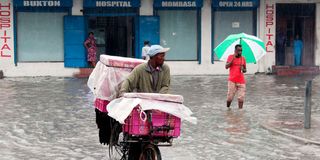Scientists turn to AI for ‘precise and timely’ weather forecasts

Residents of Mombasa wade through a flooded section of Jomo Kenyatta Avenue on May 7 after a heavy downpour. More accurate forecasts of risks of extreme weather can help officials safeguard more lives, avert damage and save money.
What you need to know:
- A new Google AI model called GenCast predicts weather events 15 days before they happen, helping officials safeguard more lives, avert damage and save money
Ms Harriet Chandi was in Korogocho, Nairobi, when a heavy downpour that turned to chaotic floods swept homes in April this year.
She was one of the few people whose houses remained grounded with minimal impact from the floodwaters.
“It was a day like any other and we all knew that it was normal rainfall that would come and go. We didn’t expect the impact would be as it was: killing people and destroying their homes and businesses,” she tells Climate Action.
When the rain continued pounding beyond their expectations, a handful of the people she knew moved to their relatives’ homes, leaving those without an option at the mercy of nature’s wrath.
Before the rain started, Harriet says she did not receive any prior warning. “It caught us off-guard. In fact, it was business as usual in our neighbourhood,” she says.
At the time, the Kenya Meteorological Department had predicted that there could be heavy downpour in some parts of the country ,sharing most of the information on Twitter.
Harriet and some of the people living in the slums did not see this information.
About 12,000 kilometres away from Harriet’s home, is Florida, a state in the United States that was in October affected by one of the worst storms christened Hurricane Milton.
On most social media platforms, especially Tiktok, everyone was talking about the hurricane, with many setting up countdowns to the actual event.
Some residents in the US went live on social media to show the world how they were preparing for the hurricane.
At the time, an Artificial Intelligence tool called GraphCast, which could only forecast weather events 10 days before they happen, accurately predicted Hurricane Milton’s outcome exactly as it happened.
Most people evacuated in good time.
Earlier that year, GraphCast had also accurately predicted that hurricane Beryl would make a landfall in another US state called Texas and not just Southern Mexico, as was predicted by a conventional model.
GraphCast was a new AI model at the time, but more studies were still in the pipeline, seeking to improve the length of prediction so that people can prepare in advance in case of an impending disaster.
A study published in the Scientific Journal Nature shows that a new Google AI model called GenCast is even better as it predicts weather events 15 days before they happen.
Lead authors of the Nature study explained in a statement that more accurate forecasts of risks of extreme weather can help officials safeguard more lives, avert damage and save money.
The scientists explain that GenCast is an AI model that is adapted to the spherical shape of the Earth and learns to accurately generate the complex probability distribution of future weather scenarios when given the most recent state of the weather as input.
“Our results indicate that probabilistic weather forecasts based on Machine Learning based weather prediction (MLWP) can be more skilful and faster to generate than the top numerical weather prediction-based ensemble (ENS) forecast,” said leading authors of the Nature study; Ilan Price and Matthew Willson in a joint statement.
“Better forecasts of extreme weather, such as heat waves or strong winds, enable timely and cost-effective preventative actions. GenCast offers greater value than ENS when making decisions about preparations for extreme weather, across a wide range of decision-making scenarios,” they added.
The scientists explain that to train this AI model, they had to feed it with four decades of historical weather data from existing archives from the old weather prediction models.
“This data includes variables such as temperature, wind speed, and pressure at various altitudes. The model learned global weather patterns, at 0.25° resolution, directly from this processed weather data,” they explained.
For the AI model to generate a 15-day forecast, it takes about eight minutes using a device called Cloud TPUv5.
“Better forecasts could play a key role in other aspects of society such as renewable energy planning. For example, improvements in wind-power forecasting directly increase the reliability of wind-power as a source of sustainable energy, and will potentially accelerate its adoption. In a proof-of-principle experiment that analysed predictions of the total wind power generated by groupings of wind farms all over the world, GenCast was more accurate than ENS,” said the scientists
“If most predictions show a cyclone hitting the same area, uncertainty is low. But if they predict different locations, uncertainty is higher. GenCast strikes the right balance, avoiding both overstating or understating its confidence in its forecasts,” they added.
This is a new field to most meteorologists.
It was Edward Lorenz, a mathematician and meteorologist from the United States Massachusetts Institute of Technology, who first came up with a theory that accurate weather forecasting can only go up to 14 days.
His assertion has remained true for decades and now the entry of the fourth industrial revolution, which has a number of technological disruptions including Artificial Intelligence, is slowly changing the game.
Before this disruption, the world’s best model for weather forecasting was the European Centre for Medium-Range Weather Forecasts’ (ECMWF) ENS.
AI models are different from the traditional ones. Artificial Intelligence can not only scrape historical data to find patterns and accurately predict what will happen, but they can also quickly detect trends that most humans may not.
Dr David Gikungu, director of Kenya Meteorological Department, said that Kenya is still discussing ways of incorporating AI in their department, but they have not started using it, just yet.
“We are still using the normal models –those based on numerical weather patterns on observed and satellite data,” he said.
“We have our own misgivings because this is a science that is still developing and we do not have enough reasons to take that direction. The status right now is more of enhancing satellite technology, but we are not dismissing it either,” he added.
Google has made GenCast an open model, saying that it is important to integrate AI with the traditional models.
"We are eager to engage with the wider weather community, including academic researchers, meteorologists, data scientists, renewable energy companies, and organisations focused on food security and disaster response,” said the scientists.
“Such partnerships offer deep insights and constructive feedback as well as invaluable opportunities for commercial and non-commercial impact, all of which are critical to our mission to apply our models to benefit humanity,” they added.
In April this year, the World Meteorological Organisation (WMO) said that it will make a deliberate move to assimilate AI to earth systems, which will help in early warning systems.
“The agility and speed of AI has already made astonishing advance. Capability for processing different data modalities such as time series forecasting, image processing or text processing, have been enhanced. These point to AI’s potential to refine the Earth system science approach by offering more accurate and unbiased information,” said the WMO.





